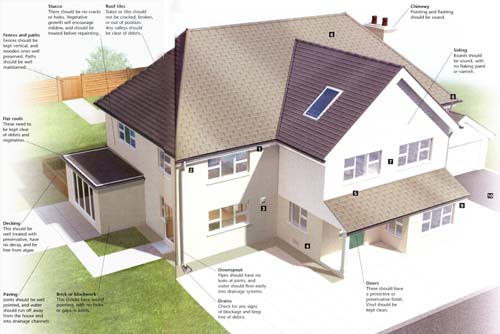The exterior of your house has to withstand the elements through all seasons. An annual inspection is important to ensure that all aspects of exterior structure are maintained. It pays to be vigilant in checking for any potential problems, because this may prevent them from escalating into something more serious. Some problems worth checking for are shown here and in the photographs below, though not all will apply to your home. You should also inspect the interior of your home for evidence of exterior problems.
Click here or image below for full size:
WHAT TO DO NEXT?
Whenever you find evidence of a problem, consider these key issues before taking any action. First, assess the physical extent of the problem, and check whether it's symptomatic of a larger issue. For example, a loose tile may simply need to be secured, or may be symptomatic of an underlying problem. Consider whether it's something you can fix yourself, or if you need to call in a professional for advice or to complete the work. Once you know what you are dealing with, assess whether the problem needs to be tackled immediately, or whether it can wait until you have the funds and the time to deal with it more easily. Problems such as leaking pipes or constantly running overflows are damaging and wasteful, and if you have a water meter they will be costing you a considerable amount of money. If the problem is a seasonal one, such as leaves blocking a gutter, it's worth planning for annual maintenance work. Remember that if you are hoping to sell your home, any problems with the exterior can seriously affect first impressions, and therefore the price you can expect to receive for your property.
- Roof tiles: Slates or tiles should not be cracked, broken, or out of position. Any valleys should be clear of debris.
- Stucco: There should be no cracks or holes. Vegetative growth will encourage mildew, and should be treated before repainting.
- Fences and paths: Fences should be kept vertical, and wooden ones well preserved. Paths should be well maintained.
- Flat roofs: These need to be kept clear of debris and vegetation.
- Decking: This should be well treated with preservative, have no decay, and be free from algae.
- Paving: Joints should be well pointed, and water should run off away from the house and into drainage channels.
- Brick or blockwork: This should have sound pointing, with no holes or gaps in joints.
- Chimney: Pointing and flashing should be sound
- Siding: Boards should be sound, with no flaking paint or varnish.
- Doors: These should have a protective or preservative finish. Vinyl should be kept clean.
- Drains: Check for any signs of blockage and keep free of debris.
- Downspout: Pipes should have no leaks at joints, and water should flow easily into drainage systems.
Drainage
Many exterior maintenance tasks involve ensuring smooth and efficient drainage from your home and into underground drainage systems in order to keep your home free from flood problems. Waste water is directed into the sewer system or septic tank through a network of underground pipes. Inspection chambers, situated below manhole covers, allow access to the pipes should problems occur. Rainwater is channeled into a separate system, or may run into the sewer. In older homes, both rainwater and waste water may drain into the sewer through the same network of pipes. Older systems should be regularly maintained, and updated when possible.
Click here or image below for full size:
1. Gutters and downspouts should be free of corrosion and leaks, and water should run easily. Remove blockages immediately.
2. Gutter downspouts must be clear of any vegetation and leaves to ensure that water drains away efficiently.
3. Vents must be clear of obstruction. This should be included as part of your boiler service schedule.
4. Air bricks should be clear, with no vegetation or garden equipment blocking any holes.
5. Flashing on roofs must be properly installed to ensure that water can't penetrate the roof.
6. Ridge tiles should all be in place, and their mortar must be in sound condition, with no cracks or holes.
7. Windows must have a protective coat of paint or finish; vinyl should be kept clean.
8. Trees close to the house may occasionally cause subsidence, and their leaves may block gutters.
9. Fascia board should be in sound condition and show no sign of decay.
10. Drives should be free of holes, craters, and standing water. Vegetation should be cleared from the surface.

